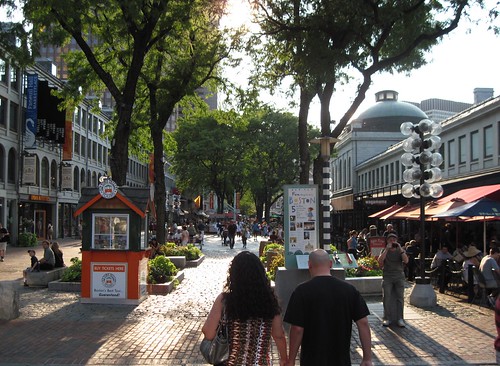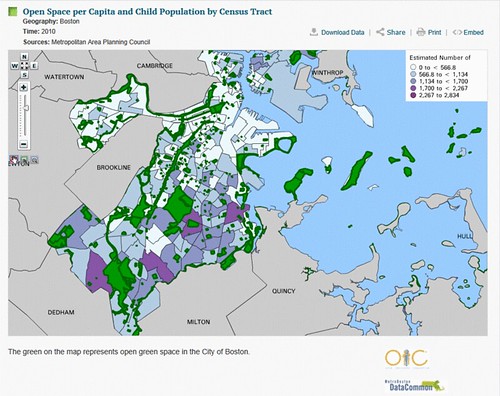Measuring life quality: the Boston Indicators Project

Posted May 13, 2013 at 1:23PM
For the past several years, the Boston Foundation has been collecting data on key indicators of the health of the city’s economic, social, and natural environment. The Boston Indicators Project surveys ten key categories relevant to quality of life:
- Civic vitality
- Cultural life and the arts
- Economy
- Education
- Environment & energy
- Health
- Housing
- Public safety
- Technology
- Transportation
The Project also examines six “crosscut topics,” including Boston neighborhoods, children and youth, “competitive edge,” fiscal health, race and ethnicity, and sustainable development.
Every two years, the Foundation issues a report of its findings, and it maintains an extensive website filled with information. In ambition, the measurements are similar to those of the Vital Signs initiative in Rockford, Illinois, and the “gross national happiness” index pursued by the Himalayan nation of Bhutan, as well as to some emerging indicators programs in Victoria, British Columbia, and Seattle. I’ll mention some of the differences but, first, let’s look at the Boston program.
The 2012 report emphasized economic vitality and inequality but, placing other issues within that frame, also delivered brief assessments of the condition of transit (with a shout to the Fairmount line and its new stations, one of which has been a focal point of a partnership involving NRDC) and the built environment (including a mention of new facilities in the Dudley neighborhood). While there are significant issues with respect to transit funding, ridership is booming and there have been some structural improvements in codes supporting smart growth:
“The Massachusetts Bay Transportation Authority (MBTA) faces a budget gap of about $1 billion annually over 20 years for maintenance and capital needs. In FY12, 45% of the operating budget of the Massachusetts Department of Transportation (MassDOT) and MBTA was used to pay off debt, and the MBTA is considering fare hikes and service cuts. At the same time, “T” ridership hit a record high in October 2011, and 25 hybrid gas-electric buses came on line . . .
“In mid-2011, 31 cities and towns in Massachusetts had approved new Smart Growth zoning overlay districts under Massachusetts Chapter 40R/40S—with 20 in Greater Boston and total of 33—up from 26 in 2009. Approved districts allow for 12,000 potential units of housing. More than 1,400 units had been issued building permits.”
I was particularly interested in the indicators used to track the built environment and transportation. That level of detail was not in the report, so I dug inside the website a bit to see what I could find.
I learned a lot, some of it superficially contradictory: For example, the apparent good news is that a full third of land in Boston is devoted to multi-family and high-density housing, with only a miniscule portion devoted to low-density housing; but the bad news is that development consumes two acres per hour in Massachusetts, 65 percent for low-density development. Those two statistics don’t make sense together unless you realize that the former is looking only inside the formal jurisdictional boundary of the city of Boston and ignores the suburbs. (City boundaries, of course, are largely ignored by today’s economy and environment.)
More significant, perhaps, is that “there are more than 1 million people and 466,000 households located within 1/2 mile of an MBTA subway or Commuter Rail station and more than 886,000 people are employed at a location within 1/2 mile of a station.” That’s not bad, though at about one-fifth of the population, there’s room for improvement. In a different section, this topic is expanded:
“Greater Boston cities and towns with the lowest vehicle miles traveled rates, less than 4,000 per year, are also those with access to the commuter rail. Some of these cities and towns are in the inner core with multiple modes of travel available, but this also holds true for municipalities outside of the 495 belt.”
That’s good news. The transportation culture of Boston seems to be that, where transit is readily available, people will use it. One third of workers in Boston (presumably the city; the site doesn’t say) reportedly take transit to work.
The website also had sections on tree cover and plantings, community gardens, and green space distribution. There was a large section on neighborhoods. The statistics for all sections of the Boston Indicators Project do appear to be much more robust for the city than for the region, and perhaps that’s understandable. It also must be said that the Foundation is undertaking a mammoth task with what are undoubtedly limited resources to devote to it while maintaining their philanthropic mission to provide financial assistance to others. But I was impressed; I could have spent all day on the site.
One obvious difference between the Boston Indicators and Rockford’s Vital Signs initiative is that the latter is being undertaken by the area’s metropolitan planning organization, not a philanthropy. It also enjoyed the benefit of significant financial assistance from the federal Department of Housing and Urban Development, and has a much smaller region to track.
But I do like that Vital Signs devotes a specific category to “built environment” and I like the specificity of its indicators, covering such subjects as adaptive re-use of existing properties, districts with smart growth policies, vacant properties, districts that meet LEED-ND standards (!), brownfields, walkability, local food production, redevelopment, and displacement of low-income residents from revitalizing areas. The Vital Signs initiative is designed as a system in which measurements are taken at multiple times throughout the 20-year planning horizon, in order to indicate progress and determine whether adjustments in strategy are necessary.
I hope the two projects in Boston and Rockford are talking to each other. They are both doing challenging but potentially very useful work. My guess is that each could learn a lot from the other’s challenges, opportunities, and experience.
Kaid Benfield will be speaking at the Boston Society or Architects on May 15, on a program co-hosted by WalkBoston.
Related posts:
- World's second-largest rooftop farm takes root in Boston (March 7, 2013)
- Boston’s Asian CDC builds community from the ground up (September 1, 2009)
- A remarkable grassroots revitalization matures and thrives in Boston (March 26, 2012)
- The environmental building blocks of urban happiness (February 2, 2012)
- Boston’s Asian CDC builds community from the ground up (September 1, 2009)
Move your cursor over the images for credit information.



